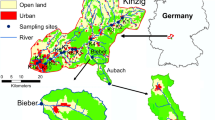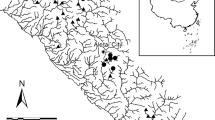Abstract
Characterizing the impacts of hydrologic alterations, pollutants, and habitat degradation on macroinvertebrate species assemblages is of critical value for managers wishing to categorize stream ecosystem condition. A combination of approaches including trait-based metrics and traditional bioassessments provides greater information, particularly in anthropogenic stream ecosystems where traditional approaches can be confounded by variously interacting land use impacts. Macroinvertebrates were collected from two rural and three urban nested study sites in central Missouri, USA during the spring and fall seasons of 2011. Land use responses of conventional taxonomic and trait-based metrics were compared to streamflow indices, physical habitat metrics, and water quality indices. Results show that biotic index was significantly different (p < 0.05) between sites with differences detected in 54 % of trait-based metrics. The most consistent response to urbanization was observed in size metrics, with significantly (p < 0.05) fewer small bodied organisms. Increases in fine streambed sediment, decreased submerged woody rootmats, significantly higher winter Chloride concentrations, and decreased mean suspended sediment particle size in lower urban stream reaches also influenced macroinvertebrate assemblages. Riffle habitats in urban reaches contained 21 % more (p = 0.03) multivoltine organisms, which was positively correlated to the magnitude of peak flows (r 2 = 0.91, p = 0.012) suggesting that high flow events may serve as a disturbance in those areas. Results support the use of macroinvertebrate assemblages and multiple stressors to characterize urban stream system condition and highlight the need to better understand the complex interactions of trait-based metrics and anthropogenic aquatic ecosystem stressors.





Similar content being viewed by others
References
Agrawal YP, Pottsmith HC (2000) Instruments for particle size and settling velocity observations in sediment transport. Mar Geol 168:89–114
Allan JD (2004) Landscapes and riverscapes: the influence of land use on stream ecosystems. Ann Rev Ecol Evol Syst 35:257–284
Allert AL, Cole-Neal CL, Fairchild JF (2012) Toxicity of chloride under winter low-flow conditions in an urban watershed in central Missouri, USA. Bull Environ Contam Toxic 89:296–301
ASTM (2007) Standard test methods for determining sediment concentration in water samples. Am Soc Test Mater:D3977–97
ASTM (2009) Standard test methods for particle-size distribution of soils using sieve analysis. Am Soc Test Mater:D6913–04
Baker DB, Richards RP, Loftus TT, Kramer JW (2004) A new flashiness index: characteristics and applications to Midwestern rivers and streams. J Ame Water Res Assoc 40:503–522
Beechie TJ, Sear DA, Olden JD, Pess GR, Buffington JM, Moir H, Roni P, Pollock MM (2010) Process-based principles for restoring river ecosystems. Bioscience 60:209–222
Bonada N, Prat N, Resh VK, Statzner B (2006) Developments in aquatic insect biomonitoring: a comparative analysis of recent approaches. Ann Rev Entomol 51:495–523
Booth DB, Jackson CJ (1997) Urbanization of aquatic systems: degradation thresholds, stormwater detention and the limits of mitigations. Water Res Bull 33:1077–1090
Carlisle DM, Hawkins CP (2008) Land use and the structure of western US stream invertebrate assemblages: predictive models and ecological traits. J N Am Benthol Soc 27:986–999
Chiariello NR, Mooney HA, Williams K (1989) Growth, carbon allocation, and cost of plant tissues. In: Pearcy RW, Ehleringer J, Mooney HA, Rundel PW (eds) Plant physiological ecology: field methods and instrumentation. Chapman and Hall, London, pp 327–365
Coulter CB, Kolka RK, Thompson JA (2004) Water quality in agricultural, urban, and mixed land use watersheds. J Am Water Res Assoc 40:1593–1601
Cuffney TF, Brightbill RA, May JT, Waite IR (2010) Responses of benthic macroinvertebrates to environmetnal changes associated with urbanization in nine metropolitan areas. Ecol Appl 20:1384–1401
Daley ML, Potter JD, McDowell WH (2009) Salinization of urbanizing New Hampshire streams and groundwater: effects of road salt and hydrologic variability. J N Am Benthtol Soc 28:929–940
Dewson ZS, James AB, Death RG (2007) A review of the consequences of decreased flow for instream habitat and macroinvertebrates. J N Am Benthol Soc 26:401–415
Doledec S, Phillips N, Scarsbrook M, Riley RH, Townsend RH (2006) Comparison of structural and functional approaches to determining landuse effects on grassland stream invertebrate communities. J N Am Benthol Soc 25(1):44–60
Feld CK, DeBello F, Doledec S (2014) Biodiversity of traits and species both show weak responses to hydromorphological alteration in lowland river macroinvertebrates. Freshw Biol 59:233–248
Hilsenhoff WL (1987) An improved biotic index of organic stream pollution. Great Lakes Entom 20:31–39
Hubbart JA, Freeman G (2010) Sediment laser diffraction: a new approach to an old problem in the central U.S. Stormwater 11:36–44
Hubbart JA, Holmes J, Bowman G (2010) TMDLs: improving stakeholder acceptance with science-based allocations. Erosion Cont 3:19–24
Hubbart JA (2012) Using sediment particle size class analysis to better understand urban land-use effects. Int J App Sci Tech 2:12–27
Hubbart JA, Kellner E, Freeman G (2014) A case study considering the comparability of mass and volumetric suspended sediment data. Environ Earth Sci 71:4051–4060. doi:10.1007/s12665-013-2788-y
ISO (1992) Water quality - measurement of biochemical parameters - spectrometric determination of the chlorophyll-a concentration. International Standard Organization ISO 10260: 1992(E)
Kaushal SS, Groffman PM, Likens GE, Belt KT, Stack WP, Kelly VR, Bandi LE, Fisher GT (2005) Increased salinization of freshwater in the northeastern United States. Proc Natl Acad Sci U S A 102:13517–13520
McMahon G, Bales JD, Coles JF, Giddings EM, Zappia H (2003) Use of stage data to characterize hydrologic conditions in an urbanizing environment. J Am Water Res Assoc 39:1529–1546
McNeil WJ (1960) Measurement of gravel composition of salmon stream beds. Fish Res Inst Circ
MDNR (1998) Missouri water quality report. Water pollution control program. Missouri Department of Natural Resources, Jefferson City
MDNR (2002) Biological assessment report. Hinkson Creek Boone County. Missouri Department of Natural Resources, Jefferson City
MDNR (2004) Hinkson Creek stream study (Phase I). Columbia, Missouri. Boone County. Missouri Department of Natural Resources. Jefferson City, Missouri
MDNR (2005) Phase II Hinkson Creek stream study. Columbia, Missouri. Boone County. Missouri Department of Natural Resources. Jefferson City, Missouri
MDNR (2006) Phase III Hinkson Creek stream study. Columbia, Missouri. Boone County. Missouri Department of Natural Resources. Jefferson City, Missouri
MDNR (2010) MDNR Project procedure. Semi-quantitative macroinvertebrate stream bioassessment project procedure. Missouri Department of Natural Resources, Jefferson City
Merritt RW, Cummins KW, Berg MB (2008) An introduction to the aquatic insects of North America, 4th edn. Kendall/Hunt Publishing, Dubuque
Nigh TA, Schroeder WA (2002) Atlas of Missouri ecological sections. Missouri Department of Conservation
Olden JD, Poff NL (2003) Redundancy and the choice of hydrologic indices for characterizing streamflow regimes. River Res Appl 19:101–121
Paul MJ, Meyer JL (2001) Streams in the urban landscape. Ann Rev Ecol Syst 32:333–365
Platts WS, Armour C, Booth GD, Bryant M, Bufford JL, Cuplin P, Jensen S, Lienkaemper GW, Minshall, GW, Monson SB, Nelson RL, Sedell JR, Tuhy JS (1987) Methods for evaluating riparian habitats with applications to management. U.S. Forest Service General Technical Report INT-221
Plafkin JL, Barbour MT, Porter KD, Gross SK, Hughes RM (1989) Rapid bioassessment protocols for use in streams and rivers: benthic macroinvertebrates and fish. United States Environmental Protection Agency. EPA/440/4-89/001
Poff NL (1997) Landscape filters and species traits: towards mechanistic understanding and prediction in stream ecology. J N Am Benthol Soc 16:391–409
Poff NL, Olden JD, Viera NK, Finn DS, Simmons MP, Kondratieff BC (2006) Functional trait niches of North American lotic insects: traits-based ecological applications in light of phylogenetic relationships. J N Am Benthol Soc 25:730–755
Pollard AI, Yuan LL (2010) Assessing the consistency of response metrics of the invertebrate benthos: a comparison of trait- and identity-based measures. Freshw Biol 55:1420–1429
Rabeni CF, Wang N, Sarver RJ (1999) Evaluating adequacy of the representative stream reach used in invertebrate monitoring programs. J N Am Benthol Soc 18:284–291
Rolls RJ, Leigh C, Sheldon F (2012) Mechanistic effects of low-flow hydrology on riverine ecosystems: ecological principles and consequences of alteration. Freshw Sci 31:1163–1186
Roy AH, Rosemond AD, Leigh DS, Paul MJ, Wallace JB (2003) Habitat-specific responses of stream insects to land cover disturbance: biological consequences and monitoring implications. J N Am Benthol Soc 22:292–307
Smith DG (2001) Pennak’s freshwater invertebrates of the United States, 4th edn. Wiley, New York
Statzner B, Beche LA (2010) Can biological invertebrate traits resolve effects of multiple stressors on running water ecosystems? Freshw Biol 55:80–119
Steuer JJ, Stensvold KA, Gregory MB (2010) Determination of biologically significant hydrologic condition metrics in urbanizing watersheds: an empirical analysis over a range of environmental settings. Hydrobiologia 654:27–55
Sudduth EB, Meyer JD (2006) Effects of bioengineered streambank stabilization on bank habitat and macroinvertebrates in urban streams. Environ Manag 38:218–226
Tarr WA (1924) Intrenched and incised meanders of some streams on the northern slope of the Ozark Plateau in Missouri. J Geol 32:583–600
Theobald DM (2001) Land-Use dynamics beyond the urban fringe. Geogr Rev 91:544–564
Toledo ZO, Kauffman JB (2001) Root biomass in relation to channel morphology of headwater streams. J Am Water Res Assoc 37:1653–1663
Tullos DD, Penrose DL, Jennings GD, Cope WG (2009) Analysis of functional traits in reconfigured channels: implications for the bioassessment and disturbance of river restoration. J N Am Benthol Soc 28:80–92
USDA (2001) Soil survey of Boone County Missouri. United States Department of Agriculture. Natural Resource Conservation Service
USEPA (1988) Ambient water quality criteria for chloride. U.S. Environmental Protection Agency, Washington. EPA-440/5-88-001
USEPA (2011) Total maximum daily load, Hinkson Creek (MO_1007 and _1008) Boone County, Missouri. U.S. Environmental Protection Agency, Washington, DC
USGS (1994) U.S. Geologic survey, Water resources division hydrologic unit maps of the coterminous United States: 1:250,000 scale, 8-digit Hydrologic Unit Codes and polygons. Reston
Vieira NK, Poff NL, Carlisle DM, Moulton SR, Koski ML, Kondratieff BC (2006) A database of lotic invertebrate traits for North America. U.S. Geological Survey Data Series 187, Reston. http://pubs.usgus.gov/ds/ds187/. Accessed 19 January 2011.
Walsh CJ, Roy AH, Feminella JW, Cottingham PD, Groffman PM, Morgan RPII (2005) The urban stream syndrome: current knowledge and the search for a cure. J N Am Benthol Soc 24:706–723
Walters AW (2011) Resistance of aquatic insects to a low-flow disturbance: exploring a trait-based approach. J N Am Benthol Soc 30:346–356
Wood DL, Sites RW (2002) Submerged rootmats: a mesohabitat harboring a distinct insect community in Ozark streams. J Freshw Ecol 17:431–440
Zar JH (1996) Biostatistical analysis, 3rd edn. Prentice-Hall, Inc, Upper Saddle River
Zuellig RE, Schmidt TS (2012) Characterizing invertebrate traits in wadeable streams of the contiguous US: differences among ecoregions and land uses. Freshw Sci 31:1042–1056
Acknowledgments
The authors would like to thank Bill Mabee and Matt Combes of the Missouri Department of Conservation for conducting the laboratory processing and identification of invertebrate samples. Funding was provided by the U.S. Environmental Protection Agency Region 7 through the Missouri Department of Natural Resources (P.N: G08-NPS-17) under Section 319 of the Clean Water Act, and the Missouri Department of Conservation. Results presented may not reflect the views of the sponsors and no official endorsement should be inferred. Collaborators include (but are not limited to) Boone County Public Works, City of Columbia, University of Missouri, and the U.S. Geological Survey. Special thanks are due to many Interdisciplinary Hydrology Laboratory scientists for field assistance and multiple reviewers whose constructive comments greatly improved the article.
Author information
Authors and Affiliations
Corresponding author
Rights and permissions
About this article
Cite this article
Nichols, J., Hubbart, J.A. & Poulton, B.C. Using macroinvertebrate assemblages and multiple stressors to infer urban stream system condition: a case study in the central US. Urban Ecosyst 19, 679–704 (2016). https://doi.org/10.1007/s11252-016-0534-4
Published:
Issue Date:
DOI: https://doi.org/10.1007/s11252-016-0534-4




